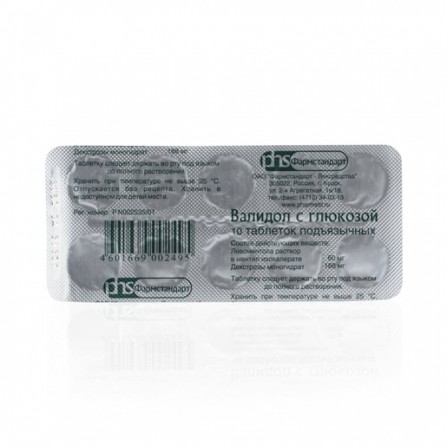Validol with glucose - Pharmstandard pills sublingual 60mg N10
Condition: New product
1000 Items
Rating:
Be the first to write a review!

More info
Active ingredients
Levomenthol solution in menthil isovalerate
Release form
Pills
Composition
1 tablet contains 188 mg of dextrose monohydrate (glucose monohydrate), 450 mg of sugar (sucrose), which corresponds to 0.054 XE, which should be considered for patients with diabetes.
Pharmacological effect
It has a sedative effect, has a moderate reflex vasodilator effect, caused by irritation of sensitive nerve endings. Stimulates the production and release of enkephalins, endorphins and a number of other peptides, histamine, kinins (due to irritation of mucosal receptors), which are actively involved in the regulation of vascular permeability, the formation of pain. With sublingual administration, the therapeutic effect on average occurs after 5 minutes, while up to 70% of the drug is released within 3 minutes.
Indications
Attacks of angina pectoris (as part of combination therapy). Neuro-circulatory dystonia of cardiac type, functional cardialgia. Neuroses. Hysteria, hysterical state. As antiemetic at sea and air diseases.
Contraindications
Increased individual sensitivity to the components of the drug. Severe hypotension.
Dosage and administration
Validol pills: 1 tablet 2-3 times a day, keep under the tongue until complete resorption.
Side effects
The use of ivabradine has been studied in clinical studies involving almost 14,000 patients. The most frequent side effects were dose-dependent in nature and were associated with the mechanism of action of ivabradine. The classification of the incidence of side effects of the World Health Organization (WHO): very often ≥1 / 10, often from ≥1 / 100 to rarely from ≥1 / 1000 to rarely from ≥1 / 10000 to very rarely of the frequency unknown can not be estimated on the basis of available data. In each group, undesirable effects are presented in order of decreasing severity. - Disorders of the organ of vision: very often a change in light perception (photopsia). Often blurred vision. - Disturbances from an organ of hearing and labyrinth disturbances. Infrequently: vertigo - Violations of the heart and blood vessels, uncontrolled blood pressure, bradycardia, AV block I degree (prolonged PQ interval on an electrocardiogram (ECG)), ventricular extrasystole, infrequently, palpitations,supraventricular premature beats, marked reduction in blood pressure, possibly associated with bradycardia, very rarely atrial fibrillation, AV block II and III degrees, sick sinus syndrome. - Nervous system disorders, often headache (especially in the first month of therapy), dizziness, possibly associated with bradycardia, syncope, possibly associated with bradycardia. Disturbances from the respiratory system, organs of the chest and mediastinum. Infrequently: shortness of breath. Violations of the skin and subcutaneous tissues. Infrequently, angioedema, skin rash, rarely pruritus, erythema, urticaria. - Disorders from the gastrointestinal tract. Infrequently nausea, constipation, diarrhea. Disorders of the musculoskeletal and connective tissue. Muscle spasms. General disorders and disorders at the injection site, asthenia, fatigue, possibly associated with bradycardia. Rarely, malaise, possibly associated with bradycardia. Laboratory and instrumental data: infrequent hyperuricemia, eosinophilia, increased plasma creatinine concentration, prolongation of the QT interval on an ECG. A change in light perception (photopsia) was noted in 14.5% of patients and was described as a transient change in brightness in a limited area of the visual field. As a rule, such phenomena were provoked by a sharp change in the intensity of illumination in the zone of the visual field. In general, photopsia appeared in the first two months of therapy, followed by repetition. The severity of photopsia, as a rule, was mild or moderate. Photopsia was stopped with continued therapy (77.5% of cases) or after its completion. In less than 1% of patients, photopsy was the cause of failure of therapy. ** Bradycardia was observed in 3.3% of patients, especially in the first 2-3 months of therapy, 0.5% of patients developed severe bradycardia with a heart rate less than or equal to 40 beats / min
special instructions
It should be administered with caution to patients with diabetes mellitus (for dosage forms containing sugar).



